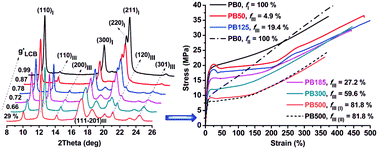Controlling crystal polymorphism of isotactic poly(1-butene) by incorporating long chain branches†
Abstract
Isotactic poly(1-butene) (iPB-1) is a high performance plastic with outstanding properties, such as flexibility, superior creep, environmental stress cracking and abrasive resistance. However, it exhibits a complex crystal polymorphism and polymorphic transformation behavior, which has limited its commercial development. In this paper, the incorporation of long chain branches (LCBs) causes coil contraction in the melt, which favors the direct melt-crystallization of form III that was generally crystallized from solutions and made of unconventional highly twined lamellae. Consequently, low-to-moderately branched iPB-1 samples as-crystallize from the melt into mixtures of form II and form III by compression-molding and fast cooling of the melt to room temperature, and the fraction of crystals of form III (fIII) increases with increasing concentration of LCBs, whereas highly branched samples can as-crystallize into pure form III with uniform crystal size distribution. The corresponding thermomechanical properties can be modified by controlling fIII.



 Please wait while we load your content...
Please wait while we load your content...